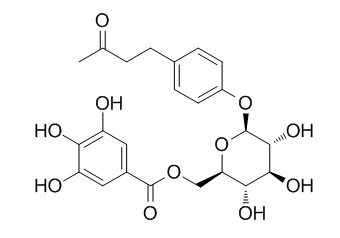Lindleyin
Lindleyin is a novel phytoestrogen and might trigger many of the biological responses evoked by the physiological estrogens.
Inquire / Order:
manager@chemfaces.com
Technical Inquiries:
service@chemfaces.com
Tel:
+86-27-84237783
Fax:
+86-27-84254680
Address:
1 Building, No. 83, CheCheng Rd., Wuhan Economic and Technological Development Zone, Wuhan, Hubei 430056, PRC
Providing storage is as stated on the product vial and the vial is kept tightly sealed, the product can be stored for up to
24 months(2-8C).
Wherever possible, you should prepare and use solutions on the same day. However, if you need to make up stock solutions in advance, we recommend that you store the solution as aliquots in tightly sealed vials at -20C. Generally, these will be useable for up to two weeks. Before use, and prior to opening the vial we recommend that you allow your product to equilibrate to room temperature for at least 1 hour.
Need more advice on solubility, usage and handling? Please email to: service@chemfaces.com
The packaging of the product may have turned upside down during transportation, resulting in the natural compounds adhering to the neck or cap of the vial. take the vial out of its packaging and gently shake to let the compounds fall to the bottom of the vial. for liquid products, centrifuge at 200-500 RPM to gather the liquid at the bottom of the vial. try to avoid loss or contamination during handling.
Toxins (Basel).2021, 13(9):593.
HortTechnology2016, 26(6):816-819
Nat Prod Sci.2014, 20(3):182-190
FARMACIA2023, Vol.71,3.
Phytother Res.2018, 32(12):2551-2559
Journal of Mushroom2023, 21(4):215-221.
Int J Mol Sci.2023, 25(1):283.
Molecules.2019, 25(1):E103
Pharmaceuticals (Basel).2024, 17(3):341.
Nutraceuticals2022, 2(3),150-161
Related and Featured Products
J Endocrinol. 2002 Nov;175(2):289-96.
The phytochemical lindleyin, isolated from Rhei rhizoma, mediates hormonal effects through estrogen receptors.[Pubmed:
12429027]
Some plant compounds or herb mixtures are popular alternatives to conventional therapies and contain organic compounds that bind to some nuclear receptors, such as the estrogen receptor (ER), to exert various biological effects. We studied the effect of various herbal extracts on ERalpha and ERbeta isoforms.
METHODS AND RESULTS:
One herbal extract, Rhei rhizoma (rhubarb), acts as an agonist to both ERalpha and ERbeta. The phytochemical Lindleyin, a major component of rhubarb, might contribute to this estrogenic activity through ERalpha and ERbeta. 4-Hydroxytamoxifen, an ER antagonist, completely reversed the estrogenic activity of Lindleyin. Lindleyin binds to ERalpha in vitro, as demonstrated using a fluorescent polarization assay. The in vivo effect of rhubarb extract was studied using a vitellogenin assay system in the freshwater fish, Japanese medaka (Oryzias latipes). There were marked increases in serum vitellogenin levels in male medaka exposed to rhubarb extract.
CONCLUSIONS:
We conclude that Lindleyin, a component of some herbal medicines, is a novel phytoestrogen and might trigger many of the biological responses evoked by the physiological estrogens.
Chem Pharm Bull (Tokyo). 2000 Jul;48(7):1055-61.
Prolyl endopeptidase inhibitory activity of fourteen Kampo formulas and inhibitory constituents of Tokaku-joki-to.[Pubmed:
10923840]
Prolyl endopeptidase (PEP, EC 3.4.21.26) is an enzyme playing a role in the metabolism of proline-containing neuropeptides which have been suggested to be involved in learning and memory processes.
METHODS AND RESULTS:
In screening for PEP inhibitors from fourteen traditional Kampo formulas, we found that Tokaku-joki-to shows a significant inhibitory activity. Examination of the constituents of the Kampo formula resulted in the isolation of two new compounds, cis-3,5,4'-trihydroxystilbene 4'-O-beta-D-(6-O-galloyl)glucopyranoside (10) and 4-(4-hydroxyphenyl)-2-butanone 4'-O-beta-D-(6-O-galloyl-2-O-cinnamoyl)glucopyranoside (16), along with twenty-five known compounds, cinnamic acid (1), protocatechuic acid (2), gallic acid (3), torachrysone 8-O-beta-D-glucoside (4), emodin (5), emodin 8-O-beta-D-glucoside (6), 3,5,4'-trihydroxystilbene 4'-O-beta-D-glucopyranoside (7), 3,5,4'-trihydroxystilbene 4'-O-beta-D-(2-O-galloyl)glucopyranoside (8), 3,5,4'-trihydroxystilbene 4'-O-beta-D-(6-O-galloyl)glucopyranoside (9), 4-(4-hydroxyphenyl)-2-butanone 4'-O-beta-D-glucopyranoside (11), isoLindleyin (12), Lindleyin (13), 4(4-hydroxyphenyl)-2-butanone 4'-O-beta-D-(2,6-di-O-galloyl)glucopyranoside (14), 4-(4-hydroxyphenyl)-2-butanone 4'-O-beta-D-(2-O-galloyl-6-O-cinnamoyl)glucopyranoside (15), 1-O-galloylglucose (17), 1,2,6-tri-O-galloylglucose (18), gallic acid 4-O-beta-D-(6-O-galloyl)glucopyranoside (19), liquiritigenin (20), liquiritigenin 4'-O-beta-D-glucoside (21), liquiritigenin 7,4'-diglucoside (22), liquiritigenin 4'-O-beta-D-apiofuranosyl-(1-->2)-beta-D-glucopyranoside (23), licuroside (24), (-)-epicatechin (25), (-)-epicatechin 3-O-gallate (26) and (+)-catechin (27).
CONCLUSIONS:
Among these compounds, twelve (7-10, 14-16, 18, 19, 24-26) showed noncompetitive inhibition with an IC50 of 22.9, 3.0, 14.9, 2.8, 10.5, 0.69, 8.2, 0.44, 9.39, 26.5, 28.1 and 0.052 microM, respectively.



